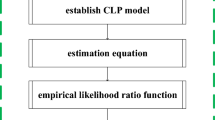Abstract
This paper focuses on the extraction of a harmonic signal from multiplicative and additive noises. A method is proposed in two stages: (1) to square the original discrete time series, which includes both signals and noises, and form a new time series. By this means, the multiplicative noise is converted to additive noise; and (2) to filter out the noise by using existing noise removal schemes. With a large amount of simulation, experimental results demonstrated the efficiency and effectiveness of this newly developed method in terms of Signal-to-Noise Ratio (SNR) and other criteria. From the experiment, it is also found that: the two kinds of noises affect the SNR differently. In general, the SNR is not influenced by multiplicative Gaussian noise regardless of its variance. However, if both kinds of noise exist, the SNR decreases with the incensement of the Variance of Additive Noise to Multiplicative Noise Ratio (VAMNR). This analysis is also supported by simulation work.
Similar content being viewed by others
References
B. Widrow, John R. Glover, Jr., et al. Adaptive noise canceling. Principles and applications. Proc. of the IEEE, 63(1975)12, 1692–1716.
S. Haykin. Adaptive Filter Theory. NJ, Prentice-Hall Inc., 1996, 562–588.
N. J. Bershad and O. Macchi. Adaptive recovery of a chirped sinusoid in noise, part 1: Performance of the RLS algorithm. IEEE Trans. on Signal Processing, 39(1991)3, 583–594.
N. J. Bershad and O. Macchi. Adaptive recovery of a chirped sinusoid in noise, part 2: Performance of the RLS algorithm. IEEE Trans. on Signal Processing, 39(1991)3, 595–602.
Li Jianping. Wavelet Analysis & Signal Processing-Theory, Applications & Software Implementations. Chongqing, Chongqing Publishing House, 1997, 193–199 (in Chinese) 李建平. 小波分析与信号处理—理论、应用及软件实现. 重庆, 重庆出版社, 1997, 193–199.
Y. Meyer. Wavelet Algorithms & Applications. New York, SIAM, 1993.
B. Sahiner and A. E. Yagle. Reconstruction from projection under time-frequency constrains. IEEE Trans. on Medical Imaging, 14(1995)2, 193–204.
C. K. Koc, G. R. Chen, and C. K. Chui. Complexity analysis of wavelet signal decomposition and reconstruction. IEEE Trans. on Aerospace and Electronic System, 30(1994)3, 910–918.
K. M. Hock. Narrowband weak signal detection by higher order spectrum. IEEE Trans. on Signal Processing, 44(1996)4, 874–879.
Masahiko Nakamura. Waveform estimation from noisy signals with variable signal delay using bispectrum averaging. IEEE Trans. on Biomedical Engineering, 40(1993)2, 118–127.
Mounir Ghogho, Mohamed Ibnkahla, and Neil J. Bershad. Analytic behavior of the LMS adaptive line enhancer for sinusoids corrupted by multiplicative and additive noise. IEEE Trans. on Signal Processing, 46(1998)9, 2386–2393.
A. Swami. Multiplicative noise models: Parameter estimation using cumulant. Signal Processing, 36(1994)3, 355–373.
G. Zhou and G. B. Giannakis. Harmonics in multiplicative and additive noise: Cramer-Rao Bounds. IEEE Trans. on Signal Processing, 43(1995)5, 1217–1231.
G. Zhou and G. B. Giannakis. Harmonics in multiplicative and additive noise: Performance analysis of cyclic estimators. IEEE Trans. on Signal Processing, 43(1995)7, 1445–1460.
A. Bovik. On detecting edges in speckle imagery. IEEE Trans. on ASSP, 36(1988)10, 1618–1627.
H. L. Van Trees. Detection, Estimation, and Modulation Theory: Radar-Sonar Signal Processing and Gaussian Signals in Noise. New York, Wiley, 1992.
F. Gini and G. B. Giannakis. Frequency offset and symbol timing recovery in flat fading channels: A cyclostationary approach. IEEE Trans. on Communications, 46(1998)3, 400–411.
John G. Proakis. Digital Communications. 4ed. New York, McGraw Hill, 2000, 231–332.
R. F. Dwyer. Fourth-order spectra of Gaussian amplitude-modulated sinusoids. J. Acoust. Soc. Amer., 90(1991)2, 918–926.
Besson and F. Castanie. On estimating the frequency of a sinusoid in autoregressive multiplicative noise. Signal Processing, 30(1993)1, 65–83
Besson and P. Stoica. Sinusoidal signals with random amplitudes: Least-squares estimators and their statistical analysis. IEEE Trans. on Signal Processing, 43(1995)11, 2733–2744
G. B. Giannakis and G. Zhou. On amplitude modulated time series, higher-order statistics and cyclostationarity. New York, Longman Chesire, 1995, 179–209.
Author information
Authors and Affiliations
Corresponding author
Additional information
Supported by the Natural Science Foundation of Shaanxi Province (No.2003F40).
About this article
Cite this article
Fan, Y., Zhang, Z., Wei, X. et al. The method of separating harmonic signals from multiplicative and additive noises. J. Electron.(China) 24, 753–759 (2007). https://doi.org/10.1007/s11767-006-0090-9
Received:
Revised:
Issue Date:
DOI: https://doi.org/10.1007/s11767-006-0090-9




